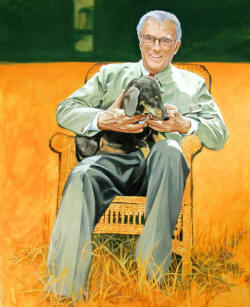

Partner Thomas Greinwald
Queer Places:
Nymphenburg Palace, Schloß Nymphenburg 1, 80638 München, Germany
Berg Palace, 82335 Berg, Germany
 Franz
Bonaventura Adalbert Maria Herzog von Bayern (born 14 July 1933), commonly
known by the courtesy title Duke of Bavaria, is the head of the House of
Wittelsbach, the former ruling family of the Kingdom of Bavaria. His
great-grandfather King Ludwig III was the last ruling monarch of Bavaria,
being deposed in 1918. Franz succeeded as head of the House of Wittelsbach,
and as pretender to the Bavarian throne, on the death of his father in 1996.
He lives at Nymphenburg Palace in Munich and Berg Palace.[2]
Franz
Bonaventura Adalbert Maria Herzog von Bayern (born 14 July 1933), commonly
known by the courtesy title Duke of Bavaria, is the head of the House of
Wittelsbach, the former ruling family of the Kingdom of Bavaria. His
great-grandfather King Ludwig III was the last ruling monarch of Bavaria,
being deposed in 1918. Franz succeeded as head of the House of Wittelsbach,
and as pretender to the Bavarian throne, on the death of his father in 1996.
He lives at Nymphenburg Palace in Munich and Berg Palace.[2]
Franz has a life partner since 1980, Thomas Greinwald, although they have never married. In August 2011, the duke appeared at Prince George Frederick of Prussia's wedding, accompanied by Greinwald and his first cousin once removed (and future heir) Prince Ludwig. They first appeared publicly as a couple in Munich in 2023.[10] The heir presumptive to the headship of the House of Wittelsbach is his brother Prince Max, Duke in Bavaria. Because Max has five daughters but no sons, he is followed in the line of succession by his and Franz's first cousin (second cousin in the male line) Prince Luitpold[11] and, in the next generation, by the latter's son Prince Ludwig of Bavaria (born 1982).
Franz was born on 14 July 1933 in Munich, as the third child and elder son of Albrecht, Duke of Bavaria, and his first wife, Countess Maria Draskovich of Trakostjan, member of the House of Drašković, an old Croatian noble family. As Maria family didn't belong to the small circle of reigning or former reigning families, his parents marriage was initially considered morganatic. But, on 18 May 1949, when Franz was 15, his grandfather Crown Prince Rupprecht recognised the marriage of Franz's parents as dynastic, and Franz became a prince of Bavaria.[3] The Wittelsbach dynasty were opposed to the Nazi regime in Germany, and in 1939, Franz's father took his family to Hungary. They lived in Budapest for four years before moving to their Castle at Sárvár in late 1943. In March 1944, Nazi Germany occupied Hungary, and on 6 October 1944 the entire family, including the 11-year-old Franz, were arrested. He spent time in several Nazi concentration camps, including Sachsenhausen concentration camp, then Flossenbürg concentration camp and finally Dachau.[1]
After the war, Franz received his secondary education at the Benedictine Abbey of Ettal. He then studied business management at the University of Munich and in Zurich. Franz developed a passion for collecting modern art. Items from his private collection are on permanent loan to the Pinakothek der Moderne in Munich.[5] He is also an honorary trustee of the Museum of Modern Art in New York.[1]
His 80th birthday party, in 2013, was held at the Schleissheim Palace near Munich. The party was attended by 2,500 guests,[6] including the then-incumbent Minister-President of Bavaria, Horst Seehofer.[7] In 2016, he became the donor of the project of restoration of the Statue of St. John of Nepomuk in Divina, Slovakia, realised under auspices of the Embassy of the Federal Republic of Germany in Slovakia. The project was honoured by patronage of Norodom Sihamoni, the king of Cambodia and Simeon II, the last tsar of Bulgaria.[8] The project was completed in the year 2017.[9]
Franz is a direct descendant of the House of Stuart. Were it not for the Act of Settlement 1701, Franz would be the successor to the British and Irish crowns of the Stuart kings.[12] His spokesman has, however, made it clear that this is a purely "hypothetical issue",[12] not a claim that he pursues.[12][13][14][15][16]
Franz is traditionally styled as His Royal Highness the Duke of Bavaria, of Franconia and in Swabia,[17] Count Palatine of the Rhine.[18][6] [19] [20] Franz was styled Prinz von Bayern at birth.[21] In 1996, after the death of his father, he changed his style to Herzog von Bayern ('Duke of Bavaria').[22]
My published books: